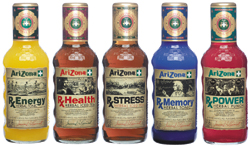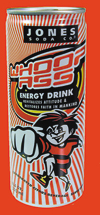
Energy drinks have
been popular for years in Asian and European countries. One of the
first commercially available drinks, Red Bull Energy Drink entered
the U.S. beverage scene about
four years ago, although it was originally introduced in Austria
in 1987. With ingredients such as B-vitamins, taurine, and caffeine,
Red Bull boasts a variety of energizing additives.
At InterBev 2000 last December in New Orleans, wide-eyed attendees bounced down the aisles energized by the array of energy elixirs. Energy drinks were cited as one of the five fastest growing products in the functional beverage segment, according to "U.S. Functional Beverage Markets," a new report from Frost & Sullivan, San Jose, Calif.
Last year, functional
beverages generated $4.7 billion in revenues, with predictions of
$12 billion by 2007, according to the report.
Energy Crisis
The quest for energy has been a common theme throughout the ages. In 1886, a new drink called Coca-Cola, containing extracts from cola nuts and coca leaves, advertised itself as an "esteemed brain tonic and intellectual beverage."Today's breed of energy drinks still include sugar and caffeine, plus a variety of energizing ingredients such as vitamins, amino acids and botanicals.
"When we create energy drinks, we research specific combinations and levels of vitamins and botanical ingredients that act synergistically to provide an energy boost," reports Dave Dafoe, technical director of Pro-Liquitech International, Louisville, Ky.
Today's energy drinks purport to provide specific energy, such as mental, sexual and physical. While energy for sport and exercise is still popular, other targeted energy drink consumers include late night workers, students and "nocturnal revelers."
The trends in today's
new age energy drinks revolve around image and size. While many
fruity energy drinks are sold in bottles for the mass market, most
energy drinks that contain a combination of B-vitamins, caffeine
and botanicals are sold in smaller slim cans. The cans help protect
light-sensitive vitamins, such as riboflavin (B12) from degradation.
Also, B-vitamins impart a yellow color.

Fuel Additives
New age energy drinks contain a variety of energizing ingredients. The major categories include carbohydrates, amino acids, vitamins, minerals, botanicals and caffeine. Suppliers can provide manufacturers with a custom nutrient premix of these ingredients and others.Carbohydrates. Through glycolysis, carbohydrates are metabolized to glucose. Usually the main source of carbohydrate in energy drinks is high-fructose corn syrup (glucose-fructose syrup) and sometimes sugar. Although carbohydrates provide four kcal/gram of energy, combinations of carbohydrates provide sustained energy as well as immediate energy.
While simple sugars elicit a rapid rise in blood sugar, complex carbohydrates such as oligosaccharides and polysaccharides produce a slower rise. Adding a combination of ingredients such as maltodextrin, corn syrups and simple sugars produces a glycemic response at different time periods.
D-ribose is a simple sugar that is the backbone of genetic material and the starting point for production of adenosine triphosphate (ATP). ATP provides the body with energy through various metabolic processes. Ribose, as a precursor to adenosine, can help reverse ATP degeneration.
Now that ribose is economically feasible for beverage manufacturers, many are adding it to their energy cocktails. "D-ribose has become a very hot ingredient in beverages right now--it is a 5-carbon simple sugar that aids in muscle recovery through more efficient recycling of ATP in the energy pathway," says Ram Chaudhari, Ph.D., vice president of R&D for an ingredient supplier. However, ribose must be used during and immediately after exercise.
Last Fall, South Beach Beverage Co., Norwalk, Conn., launched SoBe® Adrenaline Rush, a new passion fruit-flavored energy drink in black 8.2-oz. cans, to its line of wellness and energy-promoting beverages.
"We added 500 mg of D-ribose to Adrenaline Rush because we believe in its energy-enhancing effects on the body," explains Bill Meissner, director of brand development for South Beach Beverage Co. "Our tagline 'Get it up, keep it up' stems from the high levels of caffeine to get you up and D-ribose to keep the energy level there."
D-ribose can be difficult to incorporate into a nutrient premix, says Meissner. "Because D-ribose is very hygroscopic and can interact with other ingredients to produce browning, we add it separately into the beverage," he says.
Amino acids.
These protein building blocks are often added to energy and muscle-building
drinks. Many beverage formulators add amino acids such as taurine,
L-carnitine, and creatine to their products. Taurine is an important
amino acid that aids in the release of insulin and can prevent abnormal
blood clotting, a factor in the onset of heart disease.
Naturally occurring L-carnitine is found in most cells in the body, particularly the brain, neural tissues and muscles. It transports fatty acids into muscle cells for use as energy. The muscles use creatine phosphate to generate short intense bursts of energy.
Solubility, pH, and flavor are important considerations in incorporating amino acids into beverages, says Chaudhari. "Amino acids generally work better in beverages when you use some other protein source containing them, such as whey or soy protein isolate."
Not everyone is adding
amino acids to their energy drinks. "We feel there is still some
consumer skepticism about amino acids," says Marlene Coulis, brand
manager with Anheuser-Busch, St. Louis, Mo. For this reason, A-B's
new orange-citrus flavored energy drink, '180', contains guarana
as a caffeine source, B-vitamins, and vitamin C, but no amino acids.
"Malt extract is one of our company's unique ingredients that the
other energy drinks do not contain--it provides some carbohydrates."
180 went national in March.
Vitamins and minerals.
Vitamin and mineral deficiencies have been associated with a lack
of energy. Manufacturers have been adding energy-promoting vitamins
such as B and C.
Solubility can be a problem with some vitamins and minerals. The fat-soluble vitamins A, D, and E can be added as a suspension that imparts cloudiness to the beverage. While B-vitamins are water-soluble, some are less soluble than others. "Because riboflavin (B2) is not very soluble, formulators can add riboflavin 5-phosphate, a more soluble form," says Chaudhari.
B-vitamins are one of the most popular groups of vitamins added to energy drinks. Thiamin (B1), riboflavin (B2), niacin (B3), and pyridoxine (B6) work together to metabolize carbohydrates. Vitamin B12, found exclusively in animal food sources, is used by many coenzymes. B12 helps combat anemia and fatigue by working with folacin to help manufacture red blood cells.
The phosphates of
the minerals calcium and magnesium are not very soluble. Calcium
citrate or calcium lactate work better, he adds. Calcium along with
magnesium provides bone mass and plays an essential role in muscle
contractions.
Botanicals. Most suppliers of botanicals recommend levels of their extracts
based on the efficacy dosages listed in the German E Monographs.
Popular botanicals used to combat fatigue include bee pollen, royal jelly, ginkgo biloba, guarana and ginseng. For sexual energy, fo-ti, gotu kola, sarsaparilla, saw palmetto, yohimbe and Siberian ginseng are commonly used. Ginkgo biloba is purported to provide mental energy and acuity by increasing blood flow to the brain. While there is no conclusive evidence that any of these botanicals enhance energy, research is currently underway in several countries.
Most botanicals are
added to beverages as standardized liquid extracts with water/alcohol
or glycerine as solvents. Fully water-soluble spray-dried premixes
are also available.
Caffeine. Most
energy drinks contain the same amount of caffeine as in a cup of
coffee--around 80 mg. Caffeine is a well-known alkaloid stimulant
that is most often consumed in beverages derived from coffee beans,
tea leaves, cola nuts and cocoa beans.
Caffeine is absorbed rapidly and circulated to all body tissues. It effects the central nervous system, the digestive tract and the body's metabolism. It boosts adrenaline (epinephrine) levels to increase blood pressure and heart rate.
The South American
guarana berry is a natural caffeine source, containing about 2-3%
caffeine, the same amount in coffee beans, says Dave Wilson, president
of a botanical extracts supplier. A combination of guarana and caffeine
is commonly added to energy drinks.
Flavor Challenges
Making energy drinks taste good and minimizing undesirable flavors from vitamins and minerals are two of the main challenges for beverage product developers. Many claim that the first generation of energy drinks tasted poorly.Amino acids and B-vitamins pose the greatest flavor challenges for product developers. "Amino acids tend to have sulfury, meaty flavors, and B-vitamins have an aftertaste as well," says Dafoe. "Sweet flavors, vanillas or chocolates help mask undesirable notes."
Another challenge for the recent wave of energy drinks is getting the many ingredients into an 8-oz. can. "Some clients want to put every vitamin, mineral, and botanical into a small can, which gives extremely poor flavor," says Dafoe. "In some instances, we've had to remove some ingredients from a formulation."
B-vitamins go best
with citrus fruit flavors such as lemon-lime, grape and orange,
says Dafoe. "Berry flavors don't seem to cover up the vitamin notes
very well," he adds. Other masking agents include tartness from
citric and other acids and carbonation to add sparkle. PF

Canadian vs. U.S. Regulatory Hurdles
Energizing ingredients in WhoopAss Energy Drink, a carbonated beverage from Jones Soda Co., include high-fructose corn syrup, taurine, guarana, ginseng, inositol, niacin, riboflavin, vitamin B6, thiamin, royal jelly, and caffeine. The caffeine level in WhoopAss is about the same as in a cup of coffee."We chose these ingredients to maximize the energizing effects on the body," says Peter Van Stolk, Jones Soda's president and CEO. The vitamins increase metabolism; the amino acids increase energy levels; and the herbs stimulate both mental and physical activity."
Because WhoopAss is available in Vancouver, B.C., Canada as well as Seattle, Wash., Jones Soda formulated a version of the beverage for each market. WhoopAss Energy Cola is the Canadian version of WhoopAss Energy Drink, sold in the U.S.
There are several instances where Canadian regulations differ from those in the U.S. In Canada, B-vitamins are not allowed in beverages; niacin is only allowed in baby food; and caffeine is permitted only in colas and dark beverages, explains Van Stolk.
"While we feel that the U.S. product exemplifies an energy drink, we had to develop two different formulas to suit the regulations," he says. Instead of taurine, royal jelly, inositol, and B-vitamins, the Canadian cola drink contains ginkgo biloba and gotu kola, as well as guarana, ginseng and caffeine.
In the U.S. version, WhoopAss contains the following RDI's for B-vitamins: 310% thiamin, 310% riboflavin, 100% niacin, and 260% vitamin B6.